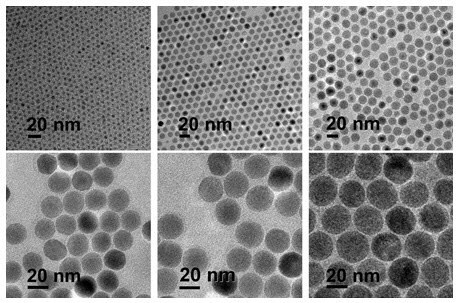Iron Oxide Nanoparticles, Characteristics and Applications
Alice Bu
Ocean NanoTech LLC
What is iron oxide?
Iron oxides are common natural compounds and can also easily be synthesized in the laboratory. There are 16 iron oxides, including oxides, hydroxides, and oxide-hydroxides. These minerals are a result of aqueous reactions under various redox and pH conditions. They have the basic composition of Fe, O, and/or OH, but differ in the valency of iron and overall crystal structure. Some of the important iron oxides are goethite, akaganeite, lepidocrocite, magnetite, and hematite.1, 2, 3
Iron oxide (IO) nanoparticles consist of maghemite (γ-Fe2O3) and/or magnetite (Fe3O4) particles with diameters ranging from 1 and 100 nanometer and find applications in magnetic data storage, biosensing, drug-delivery etc.4,5,6,7 In nanoparticles (NPs), the surface area to volume ratio increases significantly. This allows a considerably higher binding capacity and excellent dispersibility of NPs in solutions. Magnetic NPs, with sizes between 2 and 20 nm display superparamagnetism, i.e their magnetization is zero, in the absence of an external magnetic field and they can be magnetized by an external magnetic source. This property provides additional stability for magnetic nanoparticles in solutions.
IO nanoparticles have attracted considerable interest due to their superparamagnetic properties and their potential biomedical applications arising from its biocompatibility and non-toxicity.8 Recent developments in the preparation of IO nanoparticles by thermal decomposition of iron carboxylate salts have significantly improved the quality of traditional IO nanoparticles in terms of size tunability, monodispersity and crystalline structure. Using the proprietary monolayer polymer coating strategy, hydrophobic, organic ligand-coated IO nanoparticles have successfully been converted into water soluble, bio-accessible IO nanoparticles. The high stability of these water soluble IO nanoparticles in harsh conditions of high pH and elevated temperature allow conjugation of these NPs with other biomolecules. Additional biocompatible coatings for in vivo studies including polysaccharides (such as dextran) and lipid molecules have also been developed, resulting in nanoparticles consisting entirely of materials that have been approved by the United States Food and Drug Administration. Enhancement in the quality of both organic and water soluble IO nanoparticles opens avenues of opportunities for development of IO nanoparticles based applications, for example:
- As contrast agents for Magnetic Resonance Imaging (MRI)
- As drug carriers for target specific drug delivery
- As gene carriers for gene therapy
- As therapeutic agents for hyperthermia based cancer treatments
- As magnetic sensing probes for in-vitro diagnostics (IVD)
- As Nanoadjuvant for vaccine and antibody production
We are excited to offer a large and growing portfolio of magnetic nanoparticles to address any research need.

Figure 1.TEM images of 20 nm diameter Iron Oxide Nanoparticles
References
To continue reading please sign in or create an account.
Don't Have An Account?